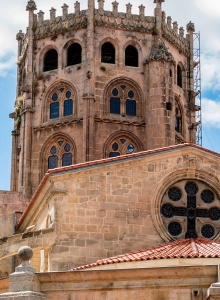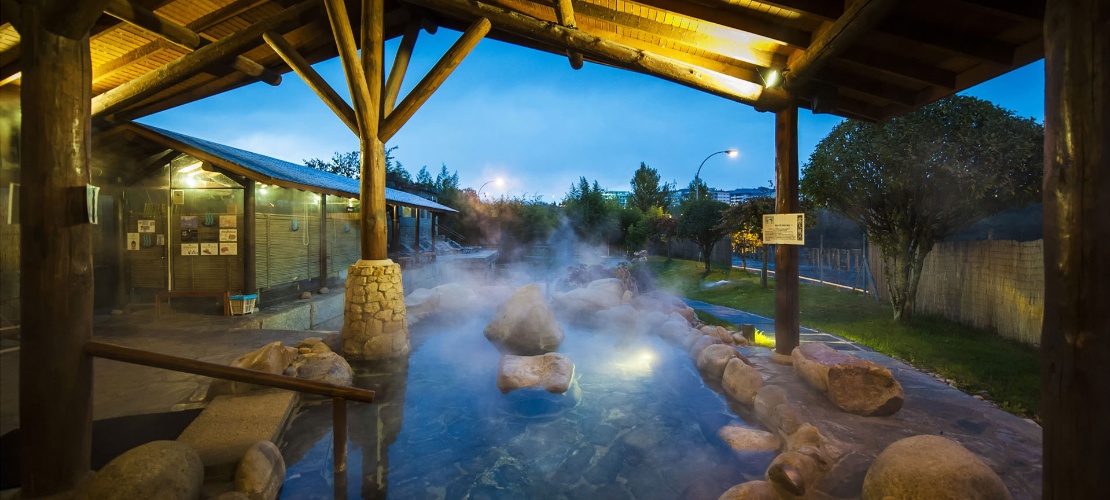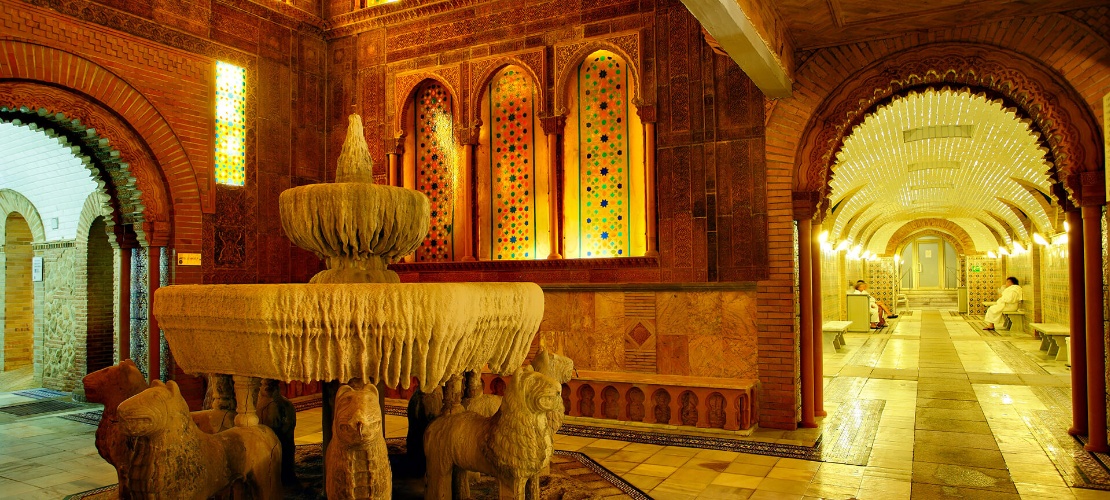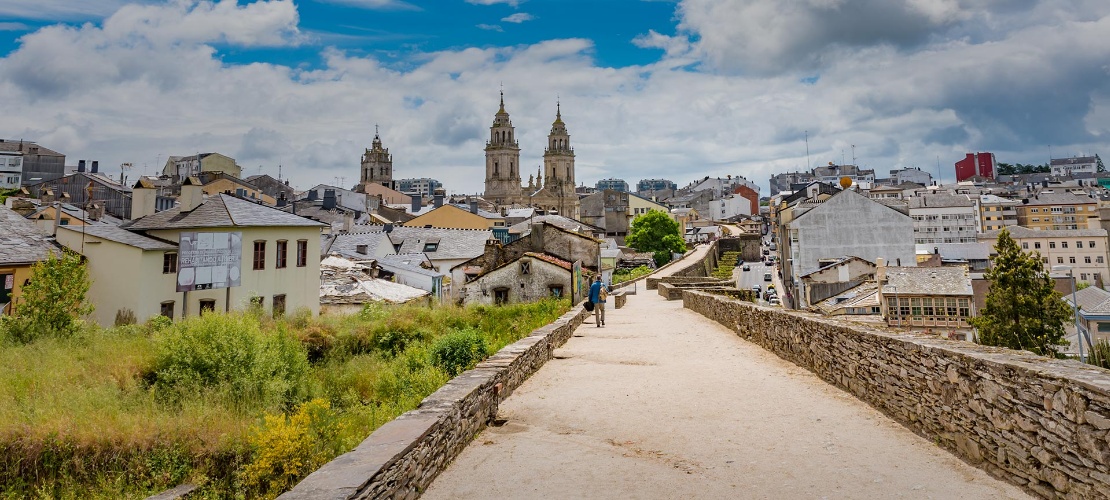Stretching out on the banks of the river Miño is the city of Ourense, which maintains its traditional link to the river through its Roman bridge. A crossroads, the Old City preserves major historic sites, outstanding among which is the Cathedral.
The river Miño, which crosses the city halfway through its course, has determined the current appearance of the provincial capital. Almost two thousand years ago, the Romans settled in this land attracted, among other reasons, by its thermal springs. The best-preserved legacy of that age is “a ponte vella” (the High bridge), which connects the banks of the Miño and which has grown to be the symbol of the city. Preserved from the original Roman bridge are some ashlar stones at the base. This major piece of civil engineering was restored in the 13th and 17th centuries, giving it its current appearance, with a pointed arch and ramps.
The capital's rich heritage can be discovered all along the streets which make up the Old City. The arcaded Main Square was the centre of the city's social and trading life, since it was here where markets, festivals and all kinds of cultural and social events were held. The City Hall building dominates the scene. Construction dates from the end of the 19th century. It has classicist façade with a balcony on the first floor and porches on the ground floor, crowned by a coat of arms and a clock at the top.
Next door is the old Episcopal Palace. This building, standing on the site of the original Roman settlement, began to be constructed in the 12th century. Featuring prominently among the subsequent extensions and remodelling is its baroque façade, added in the 18th century. The premises house the collection of the Archaeological Museum, divided into two sections: one of archaeology, which gathers a collection of objects and pieces of art from the Paleolithic period until the Middle Ages, and another of fine arts.
In the area surrounding the square you can see the church of Santa María Madre. In the baroque style, it was built in the 18th century on the site of a previous temple dating from 1084. Several columns with marble capitals can still be admired from the old basilica. The current church is composed of three bodies flanked by large towers and with coats of arms on the pediment.
Standing over the historic quarter is the clock tower attached to the Cathedral of San Martiño. The cathedral was built between the 12th and 13th centuries, its consecration coming in 1188. On the outside, the Paradise Portico, from the 13th century, is influenced by the Cathedral of Santiago de Compostela and evokes that building's Glory Portico. The south door, which gives on to plaza del Trigo, is the one which best reflects the transition of the Romanesque to the Gothic style in which the Cathedral was erected. The clock tower, meanwhile, is a subsequent addition, since it dates from the 16th century, as does the west door. Inside, the temple has a Latin cross plan, three naves and transept with a dome base in the centre. The Main Chapel houses a huge reredos created by Cornielis de Holanda in 1520 in which scenes of the Virgin Mary and Jesus appear. Among the side chapels it is worth highlighting Santo Cristo, work of Juan de Herrera (16th century), where a Gothic Christ (14th century) is venerated. The new cloister, the former Gothic cloister, houses the Cathedral Museum, which contains pieces of religious art, some of them of great value.
In these beautiful surroundings of streets and small squares filled with fountains and the traditional "cruceiros" (a stone cross standing on a column), we will find other outstanding buildings. An absolute must is the palace of Oca-Valladares, considered to be one of the most important in Galicia. Built in the 16th century, this wonderful Renaissance mansion boasts a façade of two floors and a central balcony, appearing on which are the coats of arms of several noble Galician families. In 1850, the building became the site of the Liceo Recreo, an old cultural association in Ourense.
The church of Santa Eufemia originally belonged to an old Jesuit convent. Work on this temple began in the 17th century, although it was not completed until the 18th century. From this latter period is the magnificent baroque façade, with columns and concave shapes. The church, the biggest after the Cathedral, has a Latin cross plan with three naves. Dominating the church is the baroque altar with the image of Christ of la Esperanza (18th century).
The convent of San Francisco (14th century), declared to be a Historic-Artistic Monument, is remarkable because of its cloister, one of the most important in Galicia. It has a rectangular plan and 63 pointed arches, most of them supported by doble columns. This unique and outstanding site has rich and varied decoration, with human, animal and vegetable representations appearing on the capitals, as well as in the spaces between the columns.
Before drawing a journey around the city to a close, do not forget to visit las Burgas, Ourense's famed fountains of hot springs. The oldest is Burga de Arriba, a fountain in the popular style of the 17th century. The Burga de Abajo, from the 19th century, was built in the Neoclassic style, and has three bodies and its corresponding jets. Festivals, gastronomy and surrounding area
The best way to see Ourense and its inhabitants is to plan your visit in February, since the provincial capital stages one of Spain's most unusual carnival celebrations (here called Entroido). They are known for their colour and for their traditional carnival characters (peliqueiros), which are rooted in old customs of the province.
Any of the establishments in Ourense's historic quarter offers the possibility to appreciate the excellent quality of the wines which are produced all over the province and which, in turn, fall into four Designation of Origin categories:Ribeiro, Valdeorras, Ribeira Sacra and Monterrei. Any one of them is a fine accompaniment to Ourense's substantial gastronomy. Typical dishes are octopus, meat “ó caldeiro” (beef cooked with oil, garlic and paprika) or roast kid. Eel pie is a speciality much in demand during spring. Emblematic cakes and pastries of Ourense are marrón glacé (a dessert made with chestnuts) and cañas pasteleras (cakes filled with custard).
Geographically, Ourense provincial capital is situated firmly on the Ruta de la Plata, a traditional route connecting the south and north west of the Iberian Peninsula and which was also a place pilgrims passed through on their way to Santiago de Compostela. The rest of the province offers visits to areas with a wealth of history. To the north, one of the most beautiful is Sacred Ribeira, dominated by the gorge of the river Sil and so-called because of the great many medieval monasteries and churches preserved here.
In the southern half are the two most important protected areas in Galicia, the Baixa Limia-Serra do Xurés Nature Reserve and O Invernadeiro Nature Reserve. The Parador de Verín, located opposite the fortress of Monterrei, provides the opportunity to enjoy these natural surroundings, as well as Monterrei's historic quarter, declared to be a Historic Artistic Site.

















